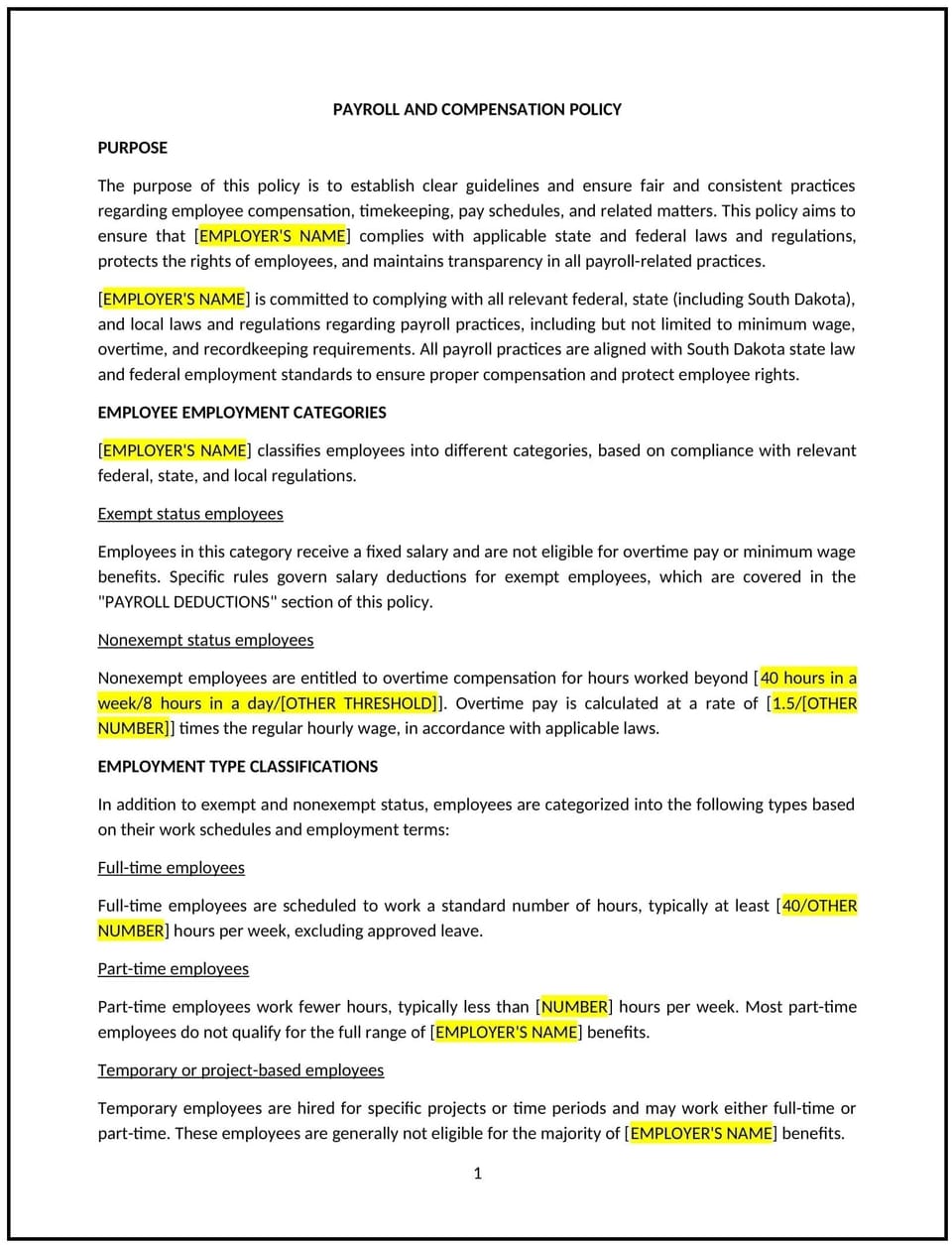Payroll and compensation policy (South Dakota): Free template

Payroll and compensation policy (South Dakota)
This payroll and compensation policy is designed to help South Dakota businesses establish guidelines for managing employee pay, benefits, and compensation-related processes. It outlines procedures for payroll processing, wage calculations, and benefit administration.
By adopting this policy, businesses can promote transparency, ensure timely and accurate payments, and align with general best practices for payroll management.
How to use this payroll and compensation policy (South Dakota)
- Define payroll and compensation: Explain what constitutes payroll, including wages, salaries, bonuses, and deductions.
- Establish pay periods: Specify the frequency of payroll processing, such as bi-weekly or monthly.
- Outline wage calculations: Provide guidelines for calculating wages, including overtime, commissions, and reimbursements.
- Address benefits administration: Specify how employee benefits, such as health insurance or retirement plans, will be managed.
- Train payroll staff: Educate payroll administrators on processing payments accurately and efficiently.
- Monitor implementation: Regularly review payroll processes to ensure adherence to the policy.
- Review and update: Assess the policy annually to ensure it aligns with evolving business needs and payroll practices.
Benefits of using this payroll and compensation policy (South Dakota)
This policy offers several advantages for South Dakota businesses:
- Promotes transparency: Demonstrates a commitment to clear and consistent payroll practices.
- Ensures accuracy: Helps prevent errors in wage calculations and benefit administration.
- Enhances employee satisfaction: Provides timely and accurate payments, boosting morale and retention.
- Builds trust: Shows employees that the business values their contributions and financial well-being.
- Supports best practices: Aligns with industry standards for payroll and compensation management.
Tips for using this payroll and compensation policy (South Dakota)
- Communicate the policy: Share the policy with employees and include it in the employee handbook.
- Provide training: Educate payroll administrators on processing payments accurately and efficiently.
- Monitor implementation: Regularly review payroll processes to ensure adherence to the policy.
- Address issues promptly: Take corrective action if payroll errors or delays occur.
- Update regularly: Assess the policy annually to ensure it aligns with evolving business needs.
Q: How does this policy benefit businesses?
A: By managing payroll and compensation effectively, businesses can promote transparency, ensure accuracy, and enhance employee satisfaction.
Q: What are typical pay periods?
A: Pay periods may be weekly, bi-weekly, or monthly, depending on the business’s structure.
Q: How are overtime wages calculated?
A: Overtime wages are typically calculated at 1.5 times the employee’s regular hourly rate for hours worked beyond 40 in a week.
Q: Can employees access their pay stubs online?
A: Yes, many businesses provide online access to pay stubs for convenience and transparency.
Q: How often should businesses review this policy?
A: Businesses should review the policy annually or as needed to ensure it aligns with evolving payroll practices.
This article contains general legal information and does not contain legal advice. Cobrief is not a law firm or a substitute for an attorney or law firm. The law is complex and changes often. For legal advice, please ask a lawyer.


